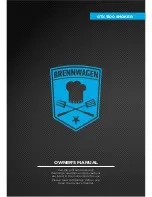
4
9
IMPORTANT SAFETY INSTRUCTIONS
READ AND SAVE THESE INSTRUCTIONS
WARNING—ALL APPLIANCES
•
Do not use water on grease fires
– Smother fire or
flame or use dry chemical or foam-type extinguisher.
•
Use only dry potholders
– Moist or damp potholders
on hot surfaces may result in burns from steam. Do
not let a potholder touch hot heating elements. Do
not use a towel or other bulky cloth.
WARNING—SURFACE COOKING UNITS
•
Use proper pan size
– This appliance may be
equipped with surface burners of different sizes.
Select utensils having flat bottoms large enough to
cover the surface burner. The use of undersized
utensils will expose a portion of the burner to direct
contact and may result in ignition of clothing. Proper
relationship of utensil to burner will also improve
efficiency.
The flame size should not extend beyond the edge of
the cooking utensil. This instruction is based on safety
considerations.
•
Never leave surface burners unattended at high
heat setting
s – Boil-over causes smoking and greasy
spillovers that may ignite.
•
If applicable, make sure drip trays are in place
–
Absence of these trays during cooking may subject
wiring or components underneath to damage.
•
Protective liners
– Do not use aluminum foil to line
oven bottoms. Improper installation of these liners
may result in a risk of electric shock, or fire.
•
Glazed cooking utensils
– Only certain types of glass,
glass/ceramic, ceramic, earthenware, or other glazed
utensils are suitable for range-top service without
breaking due to the sudden change in temperature.
•
Utensil handles should be turned inward and not
extend over adjacent surface units
– To reduce the
risk of burns, ignition of flammable materials, and
spillage due to unintentional contact with the utensil,
the handle of a utensil should be positioned so that it
is turned inward, and does not extend over adjacent
surface units.
•
Clean the cooktop with caution
– If a wet sponge or
cloth is used to wipe spills on a hot cooking area, be
careful to avoid steam burns. Some cleaners can
produce noxious fumes if applied to a hot surface.
•
Do not soak removable heating elements
– Heating
elements should never be immersed in water.
WARNING—GLASS/CERAMIC COOKING SURFACES
Do not cook on a broken cooktop
– If cooktop should
break, cleaning solutions and spillovers may penetrate the
broken cooktop and create a risk of electric shock.
Contact an authorized service provider immediately.
WARNING—INDUCTION SURFACES
Do not place metallic objects such as knives, forks,
spoons, and lids on the cooktop surface since they can get
hot.
WARNING—DEEP FAT FRYERS
Use extreme caution when moving a grease kettle or
disposing of hot grease.
WARNING—OVENS
•
Use care when opening door
– Let hot air or steam
escape before removing or replacing food.
•
Do not heat unopened food containers
– Build-up of
pressure may cause the container to burst and result in
injury.
•
Keep oven vent ducts unobstructed.
•
Placement of oven racks
– Always place oven racks in
desired location while oven is cool. If a rack must be
moved while oven is hot, do not let potholder contact
the hot heating element in oven.
WARNING—SELF-CLEANING OVENS
•
Do not clean the door gasket
– The door gasket is
essential for a good seal. Care should be taken not to
rub, damage, or move the gasket.
•
Do not use a protective coating to line the oven and
do not use a commercial oven cleaner unless certified
for use in a self-cleaning oven.
•
Clean only parts listed in manual.
•
Do not leave food or cooking utensils, etc., in an oven
during the pyrolytic self-cleaning mode of operation.
•
Please note that some pets or humans can be
sensitive to the odors created during the self-cleaning
process whether it is a manufacturing residue burn off
or food. It is recommended that those potentially
affected be removed from the kitchen area during the
self-clean process.
DO NOT TOUCH HEATING ELEMENTS OR INTERIOR
SURFACES OF OVEN
– Heating elements may be hot
even though they are dark in color. Interior surfaces of an
oven become hot enough to cause burns. During and
after use, do not touch, or let clothing or other flammable
materials contact heating elements or interior surfaces of
oven until they have had sufficient time to cool. Other
surfaces of the appliance may become hot enough to
cause burns - among these surfaces are oven vent
openings and surfaces near these openings, oven doors,
and windows of oven doors.







































